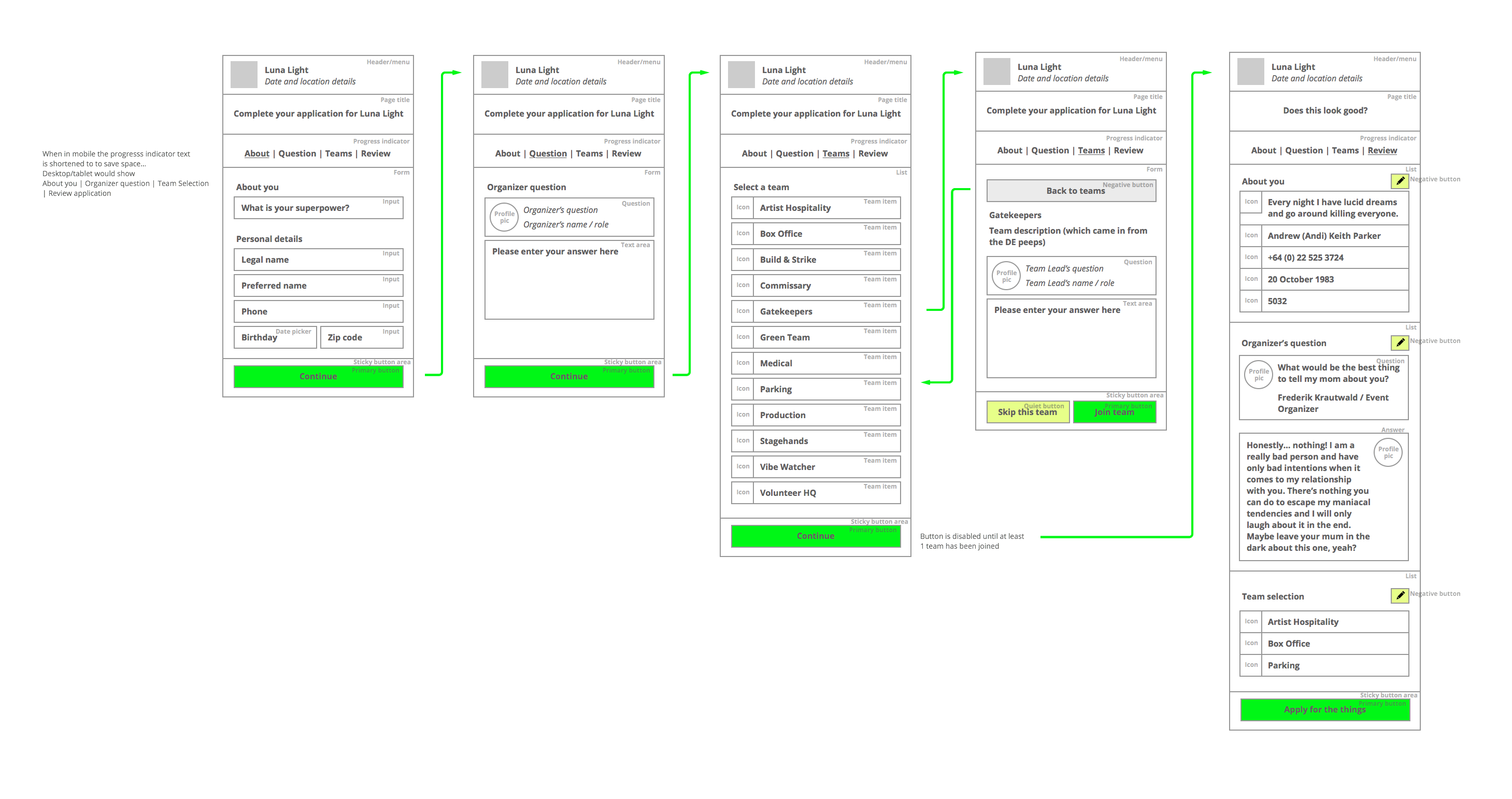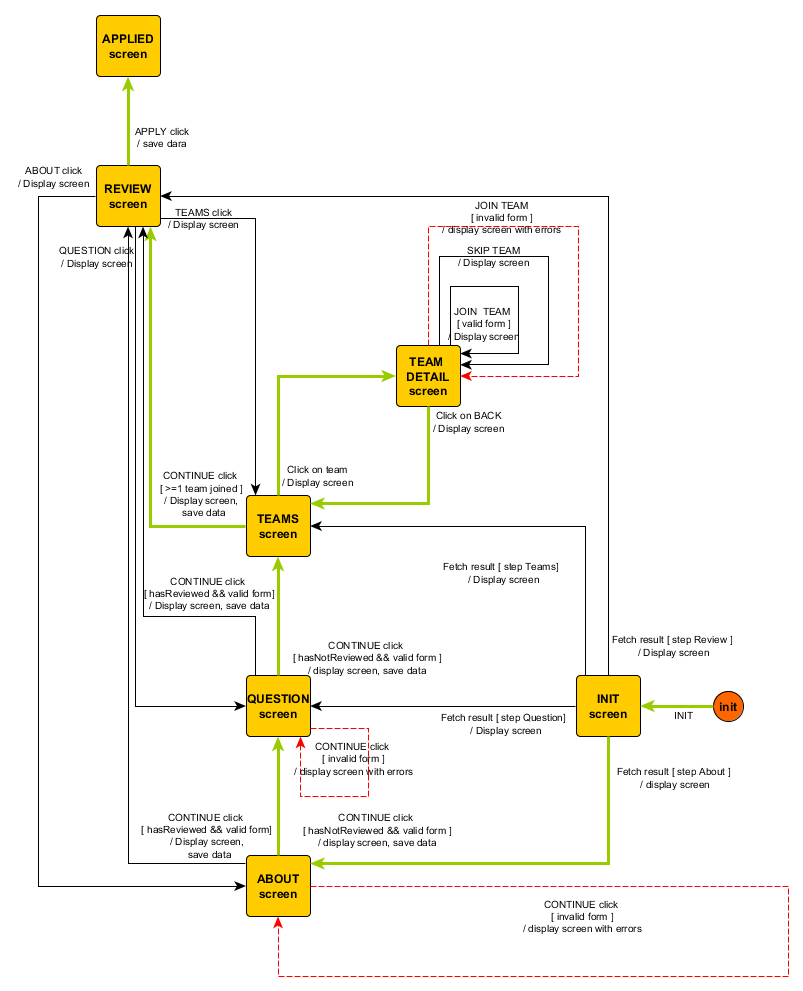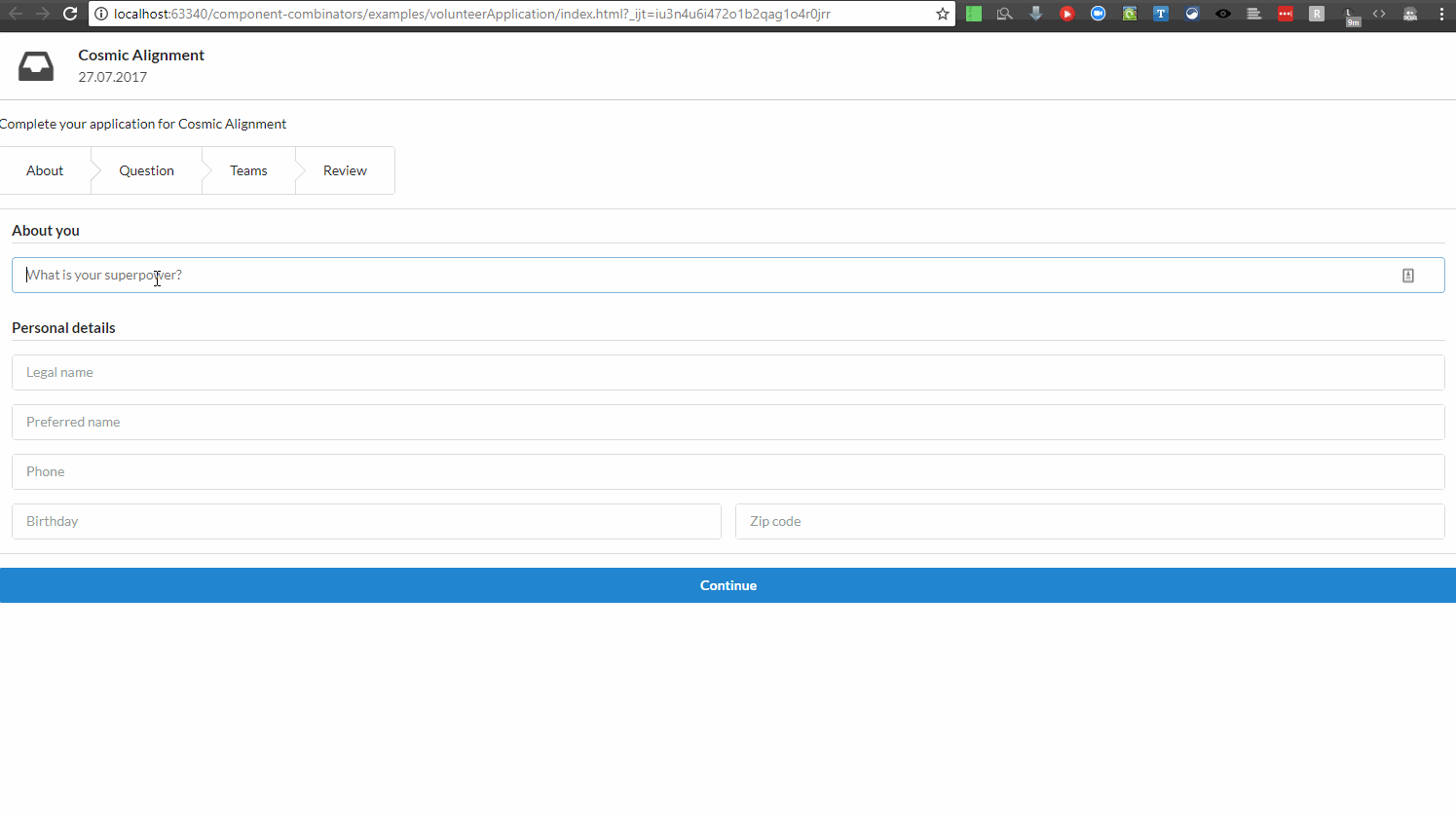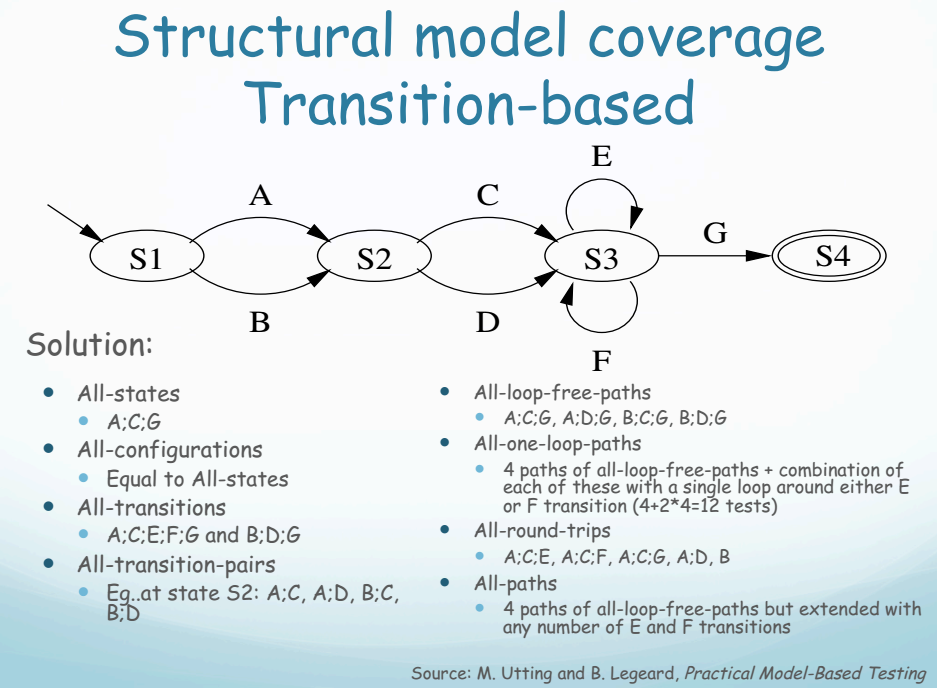brucou / Cycle State Machine Demo
Programming Languages
Projects that are alternatives of or similar to Cycle State Machine Demo
Motivation
This demo aims at showing how state machines can be used to modelize reactive systems, in particular user interfaces. They have long been used for embedded systems, in particular for safety-critical software.
We will use a real case of a multi-step workflow (the visual interface however has been changed, but the logic is the same). A user is applying to a volunteering opportunity, and to do so navigate through a 5-step process, with a specific screen dedicated to each step. When moving from one step to another, the data entered by the user is validated then saved asynchronously.
That multi-step workflow will be implemented in two iterations :
- In the first iteration, we will do optimistic saves, i.e. we will not wait or check for a confirmation message and directly move to the next step. We will also fetch data remotely and assume that fetch will always be successful (call that optimistic fetch). This will helps us showcase the definition and behaviour of an extended state machine.
- In the second iteration, we will implement retries with exponential back-off for the initial data-fetching. We will also implement pessimistic save for the most 'expensive' step in the workflow. This will in turn serve to showcase an hierarchical extended state machine.
With those two examples, we will be able to conclude by recapitulating the advantages and trade-off associated to using state machines for specifying and implementing user interfaces.
The implementation uses cyclejs as framework, and state-transducer as a state machine library.
General specifications
Here are the initial specifications for the volunteer application workflow, as extracted from the UX designers. Those initial specifications are light in details, and are simple lo-fi wireframes.
In addition, the following must hold :
- it should be possible for the user to interrupt at any time its application and continue it later from where it stopped
- user-generated data must be validated
- after entering all necessary data for his application, the user can review them and decide to modify some of them, by returning to the appropriate screen (cf. pencil icons in the wireframe)
First iteration
Modelizing the user flow with an extended state machine
On the first iteration, the provided wireframes are refined into a workable state machine, which reproduces the provided user flow, while addressing key implementation details (error flows, data fetching).
The behaviour is pretty self-explanatory. The machines moves from its initial state to the fetch state which awaits for a fetch event carrying the fetched data (previously saved application data). From that, the sequence of screens flows in function of the user flow and rules defined.
Note that we could have included processing of the fetch event inside our state machine. We could have instead fetched the relevant data, and then start the state machine with an initial INIT event which carries the fetched data. Another option is also to start the state machine with an initial extended state which includes the fetched data.
Tests
Test strategy
It is important to understand that the defined state machine acts as a precise specification for the reactive system under development. The model is precise enough to double as implementation for that reactive system (partial implementation, as our model does not modelize actual actions, nor the interfaced systems, e.g. HTTP requests, the network, etc.), but is primarily a specification of the system under study. In the context of this illustrative example, we used our state transducer library to actually implement the specified state machine.
It ensues two consequences for our tests :
- the effectful part of the reactive system must be tested separately, for instance during end-to-end or acceptance tests
- assuming that our library is correct (!), testing the implementation is testing the model, as the correctness of any one means the correctness of the other.
We thus need to test the implementation to discover possible mistakes in our model. The only way to do this is manually : we cannot use the outputs produced by the model as oracle, as they are precisely what is being tested against. Hence test generation and execution can be automated, but test validation remains manual.
That is the first point. The second point is that the test space for our implementation consists of any sequence of events admitted by the machine (assuming that events not accepted by the machine have the same effect that if they did not exist in the first place : the machine ignores them). That sequence is essentially infinite, so any testing of such reactive system necessarily involves only a finite subset of the test space. How to pick that subset in a way to generate a minimum confidence level is the crux of the matter and conditions the testing strategy to adopt.
Because our model is both specification and implementation target, testing our model involves testing the different paths in the model[^1]. Creating the abstract test suite is an easily automatable process of simply traversing through the states and transitions in the model, until the wanted model coverage is met. The abstract test suite can be reified into executable concrete test suites, and actual outputs (from the model implementation) are compared manually to expected outputs (derived from the informal requirements which originated the model).
[^1]: Those paths can be split into control paths and data paths (the latter relating to the set of values the extended state can take, and addressed by data coverage criteria). We will address only the control paths.
Miscellaneous model coverage criteria[^2] are commonly used when designing a test suite with the help of a model:
- All states coverage is achieved when the test reaches every state in the model at least once. This is usually not a sufficient level of coverage, because behavior faults are only accidentally found. If there is a bug in a transition between a specific state pair, it can be missed even if all states coverage is reached.
- All transitions coverage is achieved when the test executes every transition in the model at least once. This automatically entails also all states coverage. Reaching all transitions coverage doesn’t require that any specific sequence is executed, as long as all transitions are executed once. A bug that is revealed only when a specific sequence of transitions is executed, is missed even in this coverage level. The coverage can be increased by requiring :
-
All n-transition coverage, meaning that all possible transition sequences of
nor more transitions are included in the test suite. -
All path coverage is achieved when all possible branches of the underlying model graph are
taken (exhaustive test of the control structure). This corresponds to the previous coverage
criteria for a high enough
n - All one-loop path, and All loop-free paths are more restrictive criteria focusing on loops in the model
[^2]: Bin99 Binder, R. V., Testing object-oriented systems: models, patterns, and tools. Addison-Wesley Longman Publishing Co., Inc., Boston, MA, USA, 1999.
Using a dedicated graph testing library, we computed the abstract test suite for the All one-loop path criteria and ended up with around 1.500 tests!! We reproduce below extract of the abstract test suite:
- A test is specified by a sequence of inputs
- Every line below is a the sequence of control states the machine go through based on the
sequence of inputs it receives. Note that you can have repetition of control states, anytime a
transition happens between a state and itself. Because we have used a All one-loop path
criteria to enumerate the paths to test, every
Team_Detailloop corresponds to a different edge in the model graph. Here such loop transitions could beSkip TeamorJoin Team (valid form)orJoin Team (invalid form). We can see from the extract how the graph search works (depth-first search).
["nok","INIT_S","Review","About","Review","Question","Review","Teams","Team_Detail","Team_Detail","Team_Detail","Team_Detail","Teams","Review","State_Applied"],
["nok","INIT_S","Review","About","Review","Question","Review","Teams","Team_Detail","Team_Detail","Team_Detail","Teams","Review","State_Applied"],
["nok","INIT_S","Review","About","Review","Question","Review","Teams","Team_Detail","Team_Detail","Team_Detail","Team_Detail","Teams","Review","State_Applied"],
["nok","INIT_S","Review","About","Review","Question","Review","Teams","Team_Detail","Team_Detail","Team_Detail","Teams","Review","State_Applied"],
["nok","INIT_S","Review","About","Review","Question","Review","Teams","Team_Detail","Team_Detail","Teams","Review","State_Applied"],
["nok","INIT_S","Review","About","Review","Question","Review","Teams","Team_Detail","Team_Detail","Team_Detail","Team_Detail","Teams","Review","State_Applied"],
["nok","INIT_S","Review","About","Review","Question","Review","Teams","Team_Detail","Team_Detail","Team_Detail","Teams","Review","State_Applied"],
["nok","INIT_S","Review","About","Review","Question","Review","Teams","Team_Detail","Team_Detail","Teams","Review","State_Applied"],
["nok","INIT_S","Review","About","Review","Question","Review","Teams","Team_Detail","Teams","Review","State_Applied"],
["nok","INIT_S","Review","About","Review","Question","Review","Teams","Review","State_Applied"],
["nok","INIT_S","Review","About","Review","Question","Review","State_Applied"],
["nok","INIT_S","Review","About","Review","Question","Question","Review","Teams","Team_Detail","Team_Detail","Team_Detail","Team_Detail","Teams","Review","State_Applied"],
...
["nok","INIT_S","Review","State_Applied"]
["nok","INIT_S","About","Question","Teams","Team_Detail","Team_Detail","Team_Detail","Team_Detail","Teams","Review","About","Review","Question","Review","State_Applied"],
["nok","INIT_S","About","Question","Teams","Team_Detail","Team_Detail","Team_Detail","Team_Detail","Teams","Review","About","Review","Question","Question","Review","State_Applied"],
["nok","INIT_S","About","Question","Teams","Team_Detail","Team_Detail","Team_Detail","Team_Detail","Teams","Review","About","Review","State_Applied"],
...
["nok","INIT_S","Question","Teams","Team_Detail","Team_Detail","Team_Detail","Team_Detail","Teams","Review","About","Review","Question","Review","State_Applied"],
["nok","INIT_S","Question","Teams","Team_Detail","Team_Detail","Team_Detail","Team_Detail","Teams","Review","About","Review","Question","Question","Review","State_Applied"],
["nok","INIT_S","Question","Teams","Team_Detail","Team_Detail","Team_Detail","Team_Detail","Teams","Review","About","Review","State_Applied"],
["nok","INIT_S","Question","Teams","Team_Detail","Team_Detail","Team_Detail","Team_Detail","Teams","Review","About","About","Review","Question","Review","State_Applied"],
...(1000+ lines)
Test selection
As we mentioned, even for a relatively simple reactive system, we handed up with 1.000+ tests to exhaust the paths between initial state and terminal state, and that even with excluding n-loops.
We finally selected only 4 tests from the All path coverage set, for a total of around 50 transitions taken:
["nok","INIT_S","About","About","Question","Question","Teams","Team_Detail","Team_Detail","Team_Detail","Team_Detail","Teams","Review","Question","Review","About","Review","State_Applied"],
["nok","INIT_S","Question","Teams","Team_Detail","Team_Detail","Team_Detail","Team_Detail","Teams","Review","State_Applied"],
["nok","INIT_S","Teams","Team_Detail","Team_Detail","Team_Detail","Team_Detail","Teams","Review","State_Applied"],
["nok","INIT_S","Review","Teams","Team_Detail","Team_Detail","Team_Detail","Team_Detail","Teams","Review","State_Applied"]
Those tests :
- fulfill the All transitions coverage criteria: 4 input sequences are sufficient
- involves all the loops in the model graph (cf. first test sequence)
- insist slightly more on the core functionality of the system, which is to apply to volunteer
teams (e.g.
TEAM_DETAILloop transitions)- the transition space for that control state is the permutations of
Join(Invalid Form) x Skip x Join(Valid Form), with|set| = 2forJoinandSkip(an event triggering the associated transition happens or not). We have|Join(Invalid Form) x Skip x Join(Valid Form)| = 8, so3! x 8 = 48transition permutations for that control state. Rather than exhaustively testing all permutations, we pick 4 of them, fit into the 4 input sequences that are necessary to cover the model.
- the transition space for that control state is the permutations of
In summary the process is :
- we have informal UI requirements which are refined ino a state-machine-based detailed specification
- we generate input sequences and the corresponding output sequences, according to some model coverage criteria, our target confidence level and our testing priorities (happy path, error path, core scenario, etc.)
- we validate the selected tests manually
Test implementation
Once test sequences are chosen, test implementation is pretty straightforward. Because state transducers from our library are causal functions, i.e. function whose outputs depend exclusively on past inputs, it is enough to feed an freshly initialized state machine with a given sequence of inputs and validate the result sequence of outputs.
cf. test repository
Integration tests
Note that once the model is validated, we can use it as an oracle. This means for instance that we can take any input sequence, run it through the model, gather the resulting outputs, generate the corresponding BDD test, and run them. Most of this process can be automatized.
Implementation
We use the stream-oriented cyclejs framework to showcase our state machine library. To that purpose, we use the makeStreamingStateMachine from our library to match a stream of actions to a stream of events.
We then wire that stream of actions with cyclejs sinks. In this iteration, we make use of two
drivers : the DOM driver for updating the screen, and a domain driver for fetching data.
Code available in dedicated branch.
Run
Check-out the branch on your local computer then type npm run start in the root directory for
that branch.
Second iteration
coming soon




